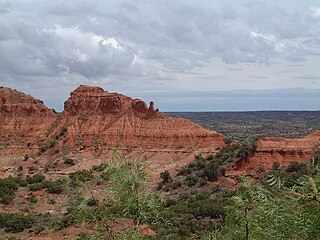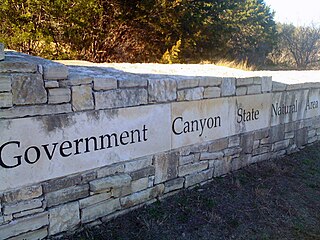
Bastrop is a city and the county seat of Bastrop County, Texas, United States. The population was 9,688 according to the 2020 census. It is located about 30 mi (48 km) southeast of Austin and is part of the Greater Austin metropolitan area.

Enchanted Rock is a pink granite mountain located in the Llano Uplift about 17 miles (27 km) north of Fredericksburg, Texas and 24 miles (39 km) south of Llano, Texas, United States. Enchanted Rock State Natural Area, which includes Enchanted Rock and surrounding land, spans the border between Gillespie and Llano counties, south of the Llano River. Enchanted Rock covers roughly 640 acres (260 ha) and rises around 425 feet (130 m) above the surrounding terrain to an elevation of 1,825 feet (556 m) above sea level. It is the largest pink granite monadnock in the United States. Enchanted Rock State Natural Area, a part of the Texas state park system, includes 1,644 acres (665 ha). In 1936, the area was designated a Recorded Texas Historic Landmark. In 1971, Enchanted Rock was designated as a National Natural Landmark by the National Park Service.

Caprock Canyons State Park and Trailway is a Texas state park located along the eastern edge of the Llano Estacado in Briscoe County, Texas, United States, approximately 100 miles (160 km) southeast of Amarillo. The state park opened in 1982 and is 15,314 acres (6,197 ha) in size, making it the third-largest state park in Texas.

Stephen F. Austin State Park is a 663.3 acres (268 ha) state park located on the Brazos River in San Felipe, Austin County, Texas, United States. The park is managed by the Texas Parks and Wildlife Department.

Cedar Hill State Park is located on FM 1382 and the eastern shore of Joe Pool Lake in Cedar Hill, Texas (USA), ten miles southwest of Dallas. The park was acquired in 1982 and was opened in 1991. The Texas Parks and Wildlife Department operates the 1,826-acre (739 ha) park.

Buescher State Park is a state park located just north of Smithville, Texas. The park consists of 1,016.7 acres (411 ha) of public land donated to the state by Mr. Emil and Mrs. Elizabeth Buescher, as well as the City of Smithville.

The Austin–Round Rock–San Marcos metropolitan statistical area, or Greater Austin, is a five-county metropolitan area in the U.S. state of Texas, as defined by the Office of Management and Budget. The metropolitan area is situated in Central Texas on the western edge of the American South and on the eastern edge of the American Southwest, and borders Greater San Antonio to the south.

Hill Country State Natural Area (HCSNA) preserves 5,369 acres (21.73 km2) of rugged, relatively pristine Hill Country terrain in Bandera County, Texas. It was opened to the public in 1984. Since HCSNA is designated a "Natural Area" rather than a "State Park", the first priority of the Texas Parks and Wildlife Department (TPWD) is the maintenance and preservation of the property's natural state. Accordingly, facilities are purposely somewhat primitive and recreational activities may be curtailed if the TPWD deems it necessary to protect the environment.

Davis Mountains State Park is a 2,709-acre (1,096 ha) state park located in the Davis Mountains in Jeff Davis County, Texas. The closest town is Fort Davis, Texas. The park elevation is between 5,000 and 6,000 ft above sea level. The original portion of the park was deeded to Texas Parks and Wildlife Department by a local family.

Cedar Creek is an census-designated place (CDP) in Bastrop County, Texas, United States. It is located about 11 miles (18 km) west of the city of Bastrop. The community takes its name from Cedar Creek, a tributary of the Colorado River that is close to the area. Cedar Creek is home to McKinney Roughs Nature Park, which features natural landscapes and an archaeological site.

Eisenhower State Park is a state park located in Grayson County, Texas, northwest of Denison, Texas on the shores of Lake Texoma. The park is 423.1 acres (171 ha).

First opened to the public in October, 2005, Government Canyon State Natural Area (GCSNA) preserves 12,244 acres of rugged hills and canyons typical of the Texas Hill Country. It is designated a Natural Area, rather than a State Park, and therefore the primary focus is maintenance and protection of the property's natural state. Accordingly, access and recreational activities may be restricted if the Texas Parks & Wildlife Department (TPWD) deems such action necessary to protect the environment.

The Lost Pines Forest is a 13-mile (21 km) belt of loblolly pines in the U.S. state of Texas, near the town of Bastrop. The stand of pines is unique in Texas because it is a disjunct population of trees that is more than 100 miles (160 km) separated from, and yet closely genetically related to, the vast expanse of pine trees of the Piney Woods region that covers parts of Texas, Arkansas, Louisiana, and Oklahoma.

The Bastrop County Complex fire was a conflagration that engulfed parts of Bastrop County, Texas, in September and October 2011. The wildfire was the costliest and most destructive wildfire in Texas history and among the costliest in U.S. history, destroying 1,696 structures and causing an estimated $350 million in insured property damage. An exceptional drought, accompanied by record-high temperatures, affected Texas for much of 2011. Vegetation consequently became severely parched throughout the state, and over the year an unprecedented amount of land in the state was burned by numerous wildfires. In early September 2011, the presence of Tropical Storm Lee to the east produced strong northerly winds over the state, exacerbating the preexisting dry weather to produce critical fire conditions. On the afternoon of September 4, 2011, three separate fires ignited in the wildland–urban interface east of Bastrop, Texas, after strong winds caused by the nearby tropical storm snapped trees onto power lines. Within 48 hours, the fires merged into one blaze that quickly consumed parts of Bastrop State Park and parts of the Lost Pines Forest, as well as homes in nearby subdivisions. Most of the conflagration's spread and destruction occurred within a week of ignition, as the forward advance of the wildfire mostly stopped after September 7. The wildfire was largely contained in September, though the firebreak was briefly breached in early October. On October 10, the Bastrop County Complex was declared controlled, and the fire was declared extinguished on October 29 after 55 days of burning within the fire perimeter.

Park Road 1 is a Park Road located in Bastrop and Buescher state parks, in the central region of the U.S. state of Texas. The highway is approximately 33.6 miles (54.1 km) long, and passes through mainly rural park land. PR 1 also includes most main roads in the two parks. Because of this, the highway has been divided into five different routes; they are PR 1A, 1B, 1C, 1D, and 1E. PR 1C makes up most of the route, while three of the segments are less than a mile long. The route was first drafted by the Civilian Conservation Corps (CCC) in 1933, as a scenic drive between the two parks. It was designated in 1937 as one of the state's originally designated Park Roads and has been extended and altered multiple times since.

Lockhart State Park is a state park located at the southwestern edge of Lockhart, Texas, United States and is administered by the Texas Parks and Wildlife Department. The park was constructed by Civilian Conservation Corps (CCC) Company 3803 between 1935 and 1938. The park officially became a state park in 1948.

Tyrrell Park is a municipal park located in Beaumont, Texas. The park has an area of around 500 acres (2.0 km2). It includes the eighteen hole Henry Homberg Golf Course; the Beaumont Botanical Gardens and Warren Loose Conservatory, the second largest public conservatory in Texas; a hiking trail; an equestrian center; and facilities for several sports and outdoor activities. Adjacent to the park is the 900 acres (4 km2) Cattail Marsh, a nature center with hiking trail. The park is located in a migratory bird flyway and Tyrrell Park is listed on the Great Texas Coastal Birding Trail.

Lake Arrowhead State Park is a state park located in Clay County, Texas, near Wichita Falls. The park is 524 acres (212 ha).

I.D. Fairchild State Forest is a 2,760-acre (1,120 ha) nature preserve in Cherokee County, Texas. It is the largest state forest in Texas and includes 10 miles of hiking trails. The main unit is located just west of the community of Maydelle on Texas State Highway 84. It is open to the public for hiking, horseback riding, picnicking, wildlife viewing, and biking. The Texas A&M Forest Service uses the area for demonstration and research as well as to conserve southern yellow pine ecosystems. The Texas State Railroad also runs through the forest.

McKinney Roughs Nature Park is a 1,140-acre (460 ha) nature park and archaeological site in Cedar Creek, Texas, United States. Located about 13 mi (21 km) east of Austin and next to the Colorado River, the park features 17.6 mi (28.3 km) of trails for hiking, mountain biking, and horseback riding. The park is owned and managed by the Lower Colorado River Authority (LCRA). During the late Archaic Period, around 2,100 years ago, McKinney Roughs served as a camping ground for prehistoric hunter-gatherers. In the 1850s, the land was owned by a ranching family that were early settlers of Texas. Over the years, it passed through various owners until it was acquired by the LCRA, which then transformed it into a nature park in 1998.































